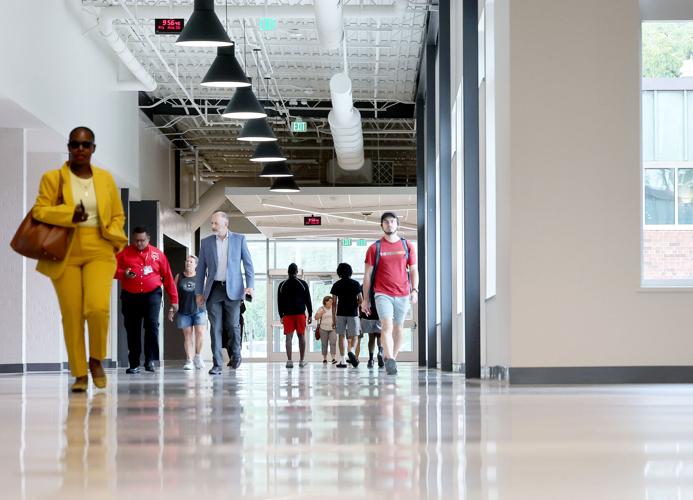Nearly two years after construction began, the renovations of Madison’s four comprehensive high schools are complete.
Funded by a $317 million referendum approved by voters in 2020, the aging schools got major upgrades. Dated hallways and cramped classrooms were replaced with bright and airy spaces geared toward modern learning.
Extra natural light, expanded arts and science classrooms, and new workshops where students can get experience working in the skilled trades were among the other improvements at East, La Follette, West and Memorial high schools, which the district showed off in a public tour Friday.
Memorial High School now has a newly improved arts wing, auditorium, planetarium and commons space.
People are also reading…
An addition to West High School at the corner of Regent Street and Highland Avenue includes a new pool, gym and locker rooms, along with new band and orchestra rooms.
East High has a new auto, metals and welding shop and updates to family and consumer sciences classrooms, the library media center and a new forum space, which includes a school store.
La Follette High School now has a new school entrance, performing arts center and gym, and an updated library.

Visitors explore the newly renovated halls of La Follette High School during a public tour Friday of the major renovations for the Madison School District's four main high schools over the past two years.
Construction on all four comprehensive high schools began in the summer of 2022. The district contracted with Findorff for most of the construction, and with Huffman Keel Partners and Eppstein Uhen Architects for design and planning.
The $317 million facilities referendum also funded a new elementary school on Madison’s South Side and paid for Capital High to relocate to a district-owned building on Regent Street.
Just the start?
The four newly renovated high schools are the beginning of the district’s long-term plan to update the look and feel of all its buildings. That will cost hundreds of millions of more dollars over the next several decades and depend on taxpayers repeatedly agreeing to give more money to the schools, Assistant Superintendent for Financial Services Bob Soldner said.
“The Madison School District needs to invest in our school facilities, and we will not be able to do it without voter approval. That fact won’t change,” Soldner said. “But it’ll be up to the board to come back and plan where we go to next.”

A new performing arts center, above, gym, school entrance and updated library are among the improvements made to La Follette High School with the Madison School District's $317 million referendum approved in 2020.
District officials hope to tick off 10 more schools from the list with a $507 million referendum up for approval in November. The district would construct five new buildings, some of which house two different schools, and renovate two elementary schools.
Construction on the first site would begin in 2026 and the final school would be finished in 2030.
Even if the $507 million referendum proposal passes, that still leaves about 30 more schools to address — the remaining middle schools not currently targeted for upgrades and the majority of the district’s elementary schools.
“We clearly have demonstrated that we’ve got 35 more buildings to talk about,” Soldner said. “If we can manage six to eight buildings every four years, we’re talking about a decades-long facility investment project.”
Pandemic impacts
The COVID-19 pandemic created unexpected challenges for the district and construction crews. Inflation drove up construction costs on the high school projects by $28 million and forced the district to cut costs by making changes, mostly small alterations.

Elements of a former gymnasium floor at La Follette High School comprise steps in the school's newly renovated “Soulful Square” commons space.
One of those changes was reducing the number of planned solar panels and electric charging stations. Slightly reducing the scope of that work saved about $10,000 at each school, according to the district.
Eliminating plans for an orchestra pit at La Follette saved about $310,000. Using a different material for fire doors at Memorial and eliminating fire alarm pull stations saved about $205,000 and $12,000, respectively. And at West, adjusting plans for lighting in the theater saved about $390,000.
The pandemic also altered the scope of work by bringing new needs to attention — such as improving HVAC systems and removing environmental hazards, such as asbestos. Additional electrical and mechanical work cost $9 million, and environmental work accounted for another $8 million.
Some of the extra money came from the district’s general education fund and from money the district saved from staff vacancies. Fundraising gave the district extra money to work with as well.

Madison schools Superintendent Joe Gothard attends a ribbon-cutting ceremony Friday for the recently renovated La Follette High School.
Although the most disruptive work took place over summer breaks, construction continued with school in session.
For teachers, staff and students, that meant working and learning in a construction zone for the better part of two years. The noise was an issue for some students, while others struggled with frequent schedule changes as areas of the schools closed and opened during construction.
For the proposed 2024 referendum construction projects, the district hopes to minimize disruptions by building new schools on nearby fields or green space the district already owns. Students could then continue learning in the original schools while the work is being done.
Those buildings could eventually be torn down or used to house students displaced by future renovations, according to information provided to the School Board.
























